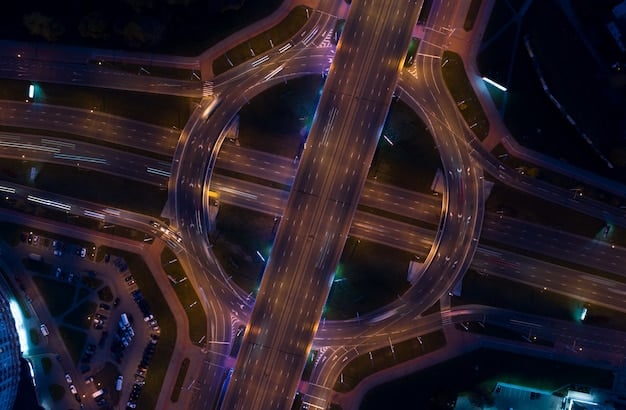White House Unveils $2 Billion Infrastructure Plan to Modernize US Transportation

The White House has announced a transformative $2 billion infrastructure plan to modernize transportation systems across the United States, aiming to enhance efficiency, safety, and sustainability for communities nationwide through targeted investments in key projects.
The Biden-Harris administration recently unveiled a groundbreaking initiative, as the White House unveils $2 billion infrastructure plan to modernize transportation systems across the United States. This substantial investment aims to address long-standing challenges in America’s aging infrastructure, paving the way for a more resilient, efficient, and equitable transportation network. This plan isn’t merely about repairing what’s old; it’s about building for the future, integrating cutting-edge technologies and sustainable practices to propel American infrastructure into the 21st century.
The Urgency of Infrastructure Modernization
The state of America’s infrastructure has been a talking point for decades, with many systems struggling to keep pace with modern demands. From crumbling bridges to congested highways and outdated rail networks, the challenges are significant. This new $2 billion plan directly confronts these issues, recognizing that robust transportation is not just a convenience, but a critical backbone for economic growth, public safety, and environmental stewardship. The administration emphasizes that these investments are foundational to national competitiveness and the daily lives of citizens.
Modernizing transportation systems goes beyond mere repairs; it involves a comprehensive upgrade that considers future needs. This includes integrating smart technologies, enhancing climate resilience, and ensuring equitable access for all communities. The goal is to create a seamless and efficient network that reduces travel times, lowers emissions, and supports sustainable economic development. This shift from reactive maintenance to proactive development is a key differentiator of the current approach.
Addressing Decades of Underinvestment
For too long, the nation has grappled with the consequences of underinvestment in its core infrastructure. Roads, bridges, and public transit systems, vital for daily commerce and personal mobility, have deteriorated, leading to inefficiencies and increased costs. This new plan specifically targets these areas, aiming to reverse the trend of neglect.
* Economic Impact: Deteriorating infrastructure costs the U.S. economy billions annually through lost productivity and increased operational expenses. The plan seeks to mitigate these losses, boosting economic activity.
* Safety Concerns: Outdated infrastructure poses significant safety risks. Modernization efforts will prioritize structural integrity and safety features, protecting motorists and commuters.
* Environmental Footprint: Investing in modern, sustainable transportation solutions can significantly reduce carbon emissions and promote cleaner modes of travel.
The Role of Smart Technology in Modernization
The $2 billion plan isn’t just about concrete and steel; it’s also about bytes and algorithms. Integrating smart technologies is crucial for building a future-proof transportation system. This includes everything from intelligent traffic management systems to advanced public transit solutions.
These technological advancements are expected to revolutionize how people move, enhancing efficiency and user experience. For example, real-time traffic data can optimize routes, reducing congestion and fuel consumption. Similarly, smart signaling systems can improve traffic flow, minimizing delays for commuters. The plan envisions a network where data-driven decisions lead to more effective and responsive transportation services.
Ultimately, the administration aims to create a dynamic infrastructure that can adapt to changing needs and technologies. This forward-looking approach ensures that the investments made today will continue to deliver benefits for decades to come, positioning the U.S. at the forefront of global infrastructure development. By focusing on both immediate needs and long-term vision, the plan seeks to deliver an infrastructure that truly serves the nation.
Key Components of the $2 Billion Plan
The recently announced $2 billion infrastructure plan is not a monolithic initiative but a multifaceted strategy with specific targets. It allocates funds across various critical sectors of transportation, ensuring that improvements are holistic and interconnected. This strategic distribution is designed to maximize impact, addressing diverse needs from urban transit to rural connectivity. Understanding these key components is essential to grasping the full scope and ambition of the White House’s vision.
The plan emphasizes several high-priority areas, reflecting a commitment to both traditional infrastructure upgrades and innovative solutions. It signifies a departure from piecemeal approaches, opting instead for a comprehensive framework that connects different modes of transport and serves a broad spectrum of communities. Each component is designed to contribute to a more resilient, efficient, and equitable national transportation network.
Investing in Roads and Bridges for Enhanced Connectivity
A substantial portion of the $2 billion package is earmarked for the revitalization of the nation’s roads and bridges. These are the arteries of American commerce and daily life, and their current state of disrepair is a major impediment. The investment aims to not only repair existing structures but also to upgrade them to withstand future challenges.
* Structural Repairs: Addressing critical repairs on thousands of miles of roads and numerous bridges that are currently rated in poor condition, reducing the risk of failures and improving safety.
* Capacity Expansion: Funding projects that increase road capacity in congested areas, helping to alleviate traffic bottlenecks and shorten commute times for millions of Americans.
* Modern Materials: Encouraging the use of innovative, sustainable materials and construction techniques that offer greater durability and reduce environmental impact.
Revolutionizing Public Transit Systems
Beyond roads, the plan dedicates significant resources to modernizing public transit systems. This is a crucial step towards reducing automobile dependency, lowering emissions, and providing more accessible transportation options, especially for urban populations. The focus is on making public transit a more appealing and viable alternative for daily commutes.
This includes investments in new rail lines, bus rapid transit systems, and the electrification of vehicle fleets. The goal is to expand service, improve reliability, and enhance the rider experience. By making public transit more efficient and user-friendly, the administration aims to encourage a shift towards more sustainable travel modes. These investments are also vital for fostering economic opportunities in urban centers, connecting communities to jobs and essential services.
The comprehensive nature of these investments underscores the Biden-Harris administration’s belief that a modern transportation system is fundamental to national prosperity and quality of life. Each component, from road improvements to transit innovations, plays a vital role in building a more efficient, safe, and sustainable future.
Economic and Social Impact of the Plan
The White House’s $2 billion infrastructure plan is not just an engineering endeavor; it is fundamentally an economic and social stimulus package designed to yield far-reaching benefits. The administration projects that these investments will catalyze job creation, stimulate economic growth, and address long-standing inequities within various communities. The ripple effects of such a substantial financial commitment are expected to be felt across diverse sectors, transforming local economies and improving the quality of life for millions of Americans.
Beyond the immediate job creation in construction and related industries, the long-term economic gains stem from increased efficiency and reduced costs for businesses reliant on transportation. Socially, the plan aims to foster greater accessibility and connectivity, particularly for underserved populations, ensuring that the benefits of modern infrastructure are broadly shared across the nation. This holistic approach seeks to rebuild not just roads and bridges, but also the economic and social fabric of communities.
Job Creation and Economic Growth Catalyzed by Infrastructure
A primary immediate benefit of the infrastructure plan is its potential to generate a significant number of jobs. These roles span a wide array of skilled and unskilled labor, from engineers and construction workers to material suppliers and administrative staff. The demand for these workers will create employment opportunities across the country, invigorating local economies.
* Direct Employment: Creation of jobs in design, construction, and maintenance of infrastructure projects. It includes a wide spectrum of roles from skilled laborers to project managers and specialized technicians.
* Indirect Employment: Growth in industries that supply materials, equipment, and services to infrastructure projects, such as steel manufacturers, concrete suppliers, and engineering firms.
* Induced Employment: Increased consumer spending by newly employed workers, supporting local businesses and further stimulating economic activity in various sectors.
Enhancing Community Connectivity and Equity
One of the core objectives of the infrastructure plan is to foster greater equity and connectivity, particularly in historically underserved communities. Many areas have been disproportionately affected by aging or inadequate infrastructure, limiting access to jobs, education, and essential services. The plan seeks to rectify these disparities.
By investing in public transit expansions, pedestrian-friendly pathways, and improved road networks in these communities, the White House aims to break down geographical barriers. This improved connectivity can lead to expanded economic opportunities, better health outcomes through easier access to healthcare, and enhanced social cohesion. The plan recognizes that equitable access to modern transportation is a fundamental right and a crucial step towards a more inclusive society. This focus on equity ensures that the benefits of infrastructure development are not concentrated, but rather dispersed, contributing to a more balanced national development.

Challenges and Solutions in Implementation
Implementing a $2 billion infrastructure plan of this magnitude is not without its complexities. While the vision is clear, the path to execution involves navigating a myriad of challenges, including securing necessary funding approvals, coordinating across multiple levels of government, and managing large-scale projects efficiently. The White House and its partners are acutely aware of these hurdles and are developing strategies to mitigate them, ensuring that the plan’s ambitious goals are met on time and within budget.
The success of this initiative hinges on effective problem-solving and adaptable approaches. From supply chain disruptions to workforce availability and environmental compliance, each obstacle requires careful consideration and a robust solution. The administration emphasizes proactive planning and collaboration as key elements in overcoming these challenges, turning potential roadblocks into opportunities for innovation and systemic improvement.
Navigating Funding and Regulatory Hurdles
Funding, while allocated, still requires careful management and adherence to strict regulatory frameworks. Ensuring that funds are disbursed efficiently and transparently is paramount to avoiding delays and waste. Moreover, infrastructure projects are subject to numerous environmental and zoning regulations that can be complex and time-consuming.
* Streamlined Approvals: Implementing processes to accelerate federal and state regulatory approvals while maintaining environmental and safety standards. This ensures projects can start and progress without undue bureaucratic delays.
* Public-Private Partnerships: Encouraging partnerships with private sector entities to leverage additional capital, expertise, and innovation, thereby diversifying funding sources and sharing risks.
* Transparency and Accountability: Establishing robust oversight mechanisms to track expenditures, project progress, and ensure accountability, minimizing opportunities for mismanagement or fraud.
Overcoming Workforce and Supply Chain Obstacles
A critical challenge for any large-scale infrastructure project is the availability of a skilled workforce and a stable supply chain. The demand for materials and labor for a $2 billion plan will be substantial, potentially leading to bottlenecks if not managed effectively. The administration is addressing these issues proactively to ensure smooth execution.
This involves investing in workforce development programs to train new skilled laborers and reskilling existing ones, ensuring a ready pool of talent for these projects. Additionally, strategies are being put in place to diversify supply chains, reducing dependency on single sources and building resilience against potential disruptions. Promoting domestic manufacturing of construction materials is also a key aspect, aiming to create jobs and bolster national self-reliance. By tackling these issues head-on, the plan seeks to create a sustainable pipeline of talent and resources, ensuring that projects can move forward without unnecessary impediments.
Sustainability and Climate Resilience in Focus
A defining characteristic of the White House’s $2 billion infrastructure plan is its explicit commitment to sustainability and climate resilience. Recognizing the escalating impacts of climate change, the plan moves beyond traditional infrastructure development to integrate environmentally conscious practices and future-proof designs. This forward-thinking approach aims not only to modernize transportation systems but also to ensure they are robust enough to withstand a changing climate while simultaneously reducing their environmental footprint.
This focus is woven into every aspect of the investment, from material selection to design principles and energy sources. It reflects a broader national strategy to build a greener economy and protect communities from extreme weather events. By prioritizing sustainability, the plan intends to create infrastructure that serves current needs without compromising the ability of future generations to meet their own.
Building Green Infrastructure for a Sustainable Future
The plan places a significant emphasis on incorporating green building practices and materials into all construction and renovation projects. This shift promotes resource efficiency and reduces the environmental impact associated with infrastructure development. The goal is to build transportation systems that are not only functional but also ecologically responsible.
* Low-Carbon Materials: Prioritizing the use of materials with lower embodied carbon, such as recycled aggregates and innovative cement blends, to reduce greenhouse gas emissions during construction.
* Renewable Energy Integration: Encouraging the use of renewable energy sources, like solar panels, for powering infrastructure components such as streetlights, charging stations, and public transit facilities.
* Green Spaces and Permeable Surfaces: Incorporating more green infrastructure elements, such as tree-lined streets and permeable pavements, to manage stormwater runoff, reduce urban heat island effects, and enhance biodiversity.
Enhancing Resilience Against Climate Change Impacts
Beyond reducing environmental impact, a core component of the plan is to build infrastructure that is resilient to the increasing frequency and intensity of climate-related disasters. This includes designing systems that can withstand extreme weather events and natural hazards, safeguarding against disruptions and damage.
Investments will be made in upgrading infrastructure to resist floods, extreme heat, wildfires, and sea-level rise. This may involve elevating critical roads, reinforcing bridges, and implementing advanced drainage systems. By embedding climate resilience into the design and construction phases, the plan aims to protect communities and ensure the continuous operation of essential transportation services, even in the face of environmental challenges. This proactive approach to climate adaptation is crucial for long-term national security and stability, ensuring that infrastructure remains reliable in an unpredictable climate future.
Community Engagement and Local Benefits
A cornerstone of the White House’s $2 billion infrastructure plan is a profound commitment to community engagement and the equitable distribution of benefits. The administration recognizes that successful infrastructure projects are not merely top-down directives but rather collaborative efforts that genuinely respond to the needs and aspirations of local populations. This focus ensures that investments are impactful where they matter most—in the daily lives of American citizens—and that the projects reflect the unique characteristics and priorities of diverse communities.
By prioritizing local input, the plan seeks to build trust, foster local ownership, and ensure that infrastructure development serves as a catalyst for positive social and economic change at the grassroots level. This approach moves beyond purely technical considerations to embrace the human element of infrastructure, aiming to improve accessibility, create local jobs, and enhance overall community well-being.
Ensuring Equitable Distribution of Investments
The plan places a strong emphasis on directing investments to communities that have historically been underserved or disproportionately affected by inadequate infrastructure. This commitment to equity ensures that the benefits of modernization are shared broadly, helping to close gaps in access and opportunity.
* Targeted Funding: Allocating specific funds to projects in low-income areas, rural communities, and urban neighborhoods that have suffered from years of disinvestment, ensuring they receive necessary upgrades.
* Inclusive Planning: Requiring project proposals to demonstrate how they will benefit disadvantaged communities, including considerations for public health, economic development, and environmental justice.
* Small Business Participation: Promoting opportunities for local small businesses and minority-owned enterprises to participate in infrastructure projects, fostering local economic growth and job creation.
The Role of Local Communities in Project Development
For the infrastructure plan to truly succeed, active participation from local communities is essential. The White House encourages a collaborative approach, where local governments, civic organizations, and residents have a voice in the planning and execution of projects that directly affect them.
This includes public forums, community meetings, and digital platforms designed to gather feedback on proposed projects and allow for local adjustments. Such engagement ensures that infrastructure solutions are tailored to specific local contexts, making them more effective and sustainable. By empowering communities to shape their own infrastructure future, the plan aims to create resilient, functional, and deeply integrated systems that truly serve the people they are built for. This bottom-up inclusion enhances project relevance and ensures long-term public support for the completed infrastructure.

Looking Ahead: The Future of American Transportation
The White House’s $2 billion infrastructure plan is more than just an immediate investment; it is a foundational step towards shaping the future of American transportation for generations to come. By addressing current deficiencies and embracing innovative solutions, the plan aims to create a dynamic, interconnected network that can adapt to evolving societal, technological, and environmental demands. This forward-looking perspective positions the United States at the forefront of global infrastructure development, enhancing competitiveness and quality of life.
The long-term vision encompasses continued technological integration, a deepening commitment to sustainability, and an enduring emphasis on equitable access. The plan sets a precedent for how future infrastructure investments will be approached, fostering a culture of continuous improvement and adaptation. It signals a move towards a transportation future that is not only efficient and reliable but also resilient, environmentally responsible, and socially just.
Technological Integration and Automation
A significant aspect of the future that the plan helps to usher in is the deeper integration of technology and automation into transportation systems. This includes exploring and deploying advancements that promise to revolutionize how people and goods move, offering unprecedented levels of efficiency and safety.
* Autonomous Vehicles: Investing in infrastructure that supports the safe and efficient operation of autonomous vehicles, including smart roadways and advanced communication networks between vehicles and infrastructure.
* Smart Traffic Management: Leveraging AI and big data analytics to optimize traffic flow, reduce congestion, and enhance overall network performance, leading to shorter travel times and reduced emissions.
* Integrated Mobility Platforms: Fostering the development of platforms that seamlessly integrate various modes of transport—from ride-sharing to public transit and micromobility—providing users with comprehensive, real-time travel options.
Long-Term Vision for Resilient Infrastructure
The plan lays the groundwork for a long-term strategy focused on building infrastructure that is inherently resilient and adaptable. This vision recognizes that future challenges, particularly those related to climate change, will require robust and flexible transportation systems capable of withstanding diverse impacts.
This includes pioneering new materials and construction techniques that offer greater durability and resistance to extreme weather events. The focus is on creating infrastructure that not only stands the test of time but also remains functional and reliable even under adverse conditions. Furthermore, the plan encourages continuous research and development in engineering and urban planning, ensuring that America’s transportation infrastructure remains at the cutting edge. By investing in resilience today, the White House aims to protect future generations from costly disruptions and ensure that the nation’s transportation network serves as a pillar of strength and stability.
| Key Point | Brief Description |
|---|---|
| 🛠️ Modernization Goal | The plan aims to revitalize and upgrade aged U.S. transportation systems for increased efficiency, safety, and sustainability. |
| 💰 Funding Allocation | A significant $2 billion investment targets roads, bridges, and public transit, promoting holistic infrastructure improvements. |
| 🌱 Sustainability Focus | Emphasizes green construction, renewable energy, and climate resilience to build infrastructure that endures environmental challenges. |
| 🤝 Community Engagement | Prioritizes local input and equitable distribution of benefits, especially in underserved communities, for relevant and impactful projects. |
Frequently Asked Questions About the Infrastructure Plan
The primary goal is to modernize and upgrade existing U.S. transportation systems, including roads, bridges, and public transit. This aims to enhance efficiency, safety, and sustainability across the nation. The plan also seeks to integrate advanced technologies to future-proof the American infrastructure, ensuring long-term resilience and economic benefits for all communities.
The plan is expected to create a significant number of direct and indirect jobs in construction, engineering, and related industries. By improving transportation efficiency, it will also reduce costs for businesses, stimulate economic growth, and increase productivity across various sectors, contributing to a more robust and competitive national economy.
The $2 billion investment will primarily benefit roads, bridges, and public transit systems. This includes funding for structural repairs, capacity expansion, and the adoption of modern, sustainable materials. The plan also supports the electrification of public transit fleets and the integration of smart technologies to revolutionize urban mobility.
The plan integrates green building practices, promotes the use of low-carbon materials, and encourages renewable energy integration in infrastructure projects. It also focuses on enhancing resilience against climate change impacts by designing systems that can withstand extreme weather events, ensuring long-term operability and environmental responsibility.
Yes, community engagement is a cornerstone of the plan. The White House emphasizes active participation from local governments, civic organizations, and residents through public forums and feedback mechanisms. This ensures investments align with local needs, particularly in underserved areas, fostering equitable distribution of benefits and sustainable impactful projects.
Conclusion
The White House’s unveiling of a substantial $2 billion infrastructure plan marks a pivotal moment for American transportation. This ambitious initiative is more than just an allocation of funds; it is a strategic vision to fundamentally transform the nation’s aging infrastructure into a modern, resilient, and equitable network. By focusing on critical upgrades to roads, bridges, and public transit, while simultaneously prioritizing sustainability, technological integration, and community engagement, the plan addresses both immediate needs and long-term challenges. As the implementation unfolds, the projected benefits—from job creation and economic growth to enhanced safety and environmental stewardship—promise to redefine the future of how Americans travel and connect, ushering in an era of unprecedented progress in infrastructure development.





